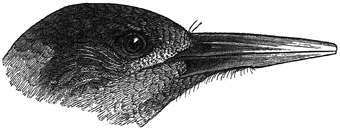|
Page 19 | prev page next page | ||
|
Genus Pyrrhopicus, Malherbe, 1861 Bill long and stout, culmen angulate, almost straight; nasal ridge strongly developed, nearer to the culmen than to the commissure at the base of the bill; nostrils open, not concealed by plumes; chin-angle nearly halfway from gape to tip of bill; no crest. Wings rounded, primaries scarcely exceeding secondaries in length; tail short; outer pair of tail-feathers longer than the coverts; first toe well-developed; fourth (or reversible) toe a little longer than third. Colour bay above more or less banded with black, very dark brown beneath, a partial red collar in males. Only two species are known.
Key to the Species The oldest name for this genus, Venilia (of which the type appears to have been V. porphyromelas, Bp. Consp.i. p.128) cannot be used, as it had previously been employed in both Lepidoptera and Mollusca. Lepocestes of Cabanis (1863) has been adopted by Hargitt, but Pyrrhopicus and Plinthopicus of Malherbe date from 1861, and I accept the first. Blythipicus of Bonaparte (1854) is generally regarded as too absurd a term to be admitted.
|
| ||
|
Coloration: Bill pale greenish yellow; irides reddish orange to brownish red; legs and feet very dark green (Davison). Male. Whole head brown, the forehead, sides of head, and chin paler; feathers of forehead and crown pale-shafted. A bright crimson half-collar behind the ear-coverts extending more or less completely round the nape; all upper parts from the nape, with wing-feathers and coverts, barred rufous and black, the rufous bars broadest on the quills. Back-feathers fringed with deeper red; tail-feathers rufous with black spots, forming imperfect bars, on both webs, shafts of quills and tail-feathers light red. Lower parts from throat olive-brown, reddish on the breast, dusky on the abdomen. A few narrow rufous bands on the lower flanks and under tail-coverts. The female wants the crimson half-collar. The young have pale shaft-lines throughout the head and neck, and traces of bars on the breast and abdomen. Size: Length 11.5; tail 4; wing 5.75; tarsus 1.1; bill from gape 1.9 Distribution: From the eastern Himalayas (Nepal, Sikhim, Dafla hills) to the Malay peninsula, throughout Burma and other intervening countries. Habits: An inhabitant of dense underwood, keeping very much to the ground, and rarely ascending a tree unless disturbed. This bird is generally found in pairs or small parties, is very vociferous and has a loud screeching call. The eggs do not appear to have been observed.
Coloration: Bill chrome-yellow, tinged with green towards the base; irides red; legs and feet dark, varying in shade, generally purplish or purplish brown (Davison). Male. Whole head brown, paler in front all round the base of the bill; feathers on each side of the neck behind the ear-coverts tipped with bright crimson, forming blood-red patches; some of the malar feathers tinged red in some specimens; whole upper plumage from nape, including the edges of the quills, dull crimson; feathers of rump and upper tail-coverts, quills and tail-feathers very dark brown with narrow bars of pale rufescent brown, well marked on outer webs of all wing-feathers, but except on the tertiaries faint on the inner webs; lower plumage from throat very dark olive-brown, the breast with a reddish tinge. The female wants the red patches behind the ears. Size: Length 9; tail 3; wing 4.8; tarsus 0.9; bill from gape 1.45. Distribution: Malay Peninsula, extending into Tenasserim as far north as Bopyin, south of Mergui, and also into Sumatra and Borneo. Common in the extreme south of Tenasserim.
Habits: Like P. pyrrhotis, this species is said by Davison to
be very shy arid to keep much to the underwood of the evergreen forests; it
avoids the larger trees, is generally found in pairs and utters incessantly a
sharp metallic note. | |||
| prev page :: next page | |||
 birding.in
birding.in
| Birds | Bird Diagram | Ornithology | Indian Sites | Bird Watching | Migration | North India | Birds of India | Haryana |
All rights reserved. Copyright © 2005-2013 Birds and birding in India. Disclaimer
website: Free Java Guide & Tutorials
